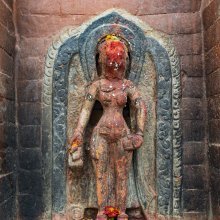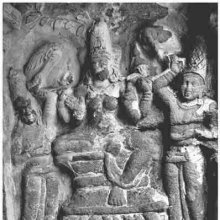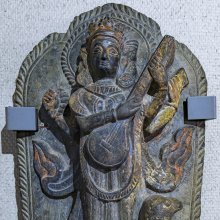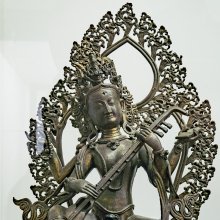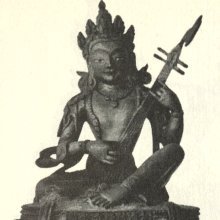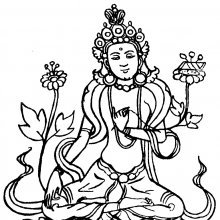Sarasvati, Sarasvatī: 46 definitions
Introduction:
Sarasvati means something in Buddhism, Pali, Hinduism, Sanskrit, Jainism, Prakrit, the history of ancient India, Marathi, Hindi, biology, Tamil. If you want to know the exact meaning, history, etymology or English translation of this term then check out the descriptions on this page. Add your comment or reference to a book if you want to contribute to this summary article.
Images (photo gallery)
(+27 more images available)
In Hinduism
Natyashastra (theatrics and dramaturgy)
Source: Wisdom Library: Nāṭya-śāstra1) Sarasvatī (सरस्वती) is a Sanskrit word referring to a goddess. Acording to the Nāṭyaśāstra 1.88-95, when Brahmā, Indra and all other gods went to inspect the playhouse (nāṭyamaṇḍapa) designed by Viśvakarmā, he assigned different deities for the protection of the playhouse itself, as well as for the objects relating to dramatic performance (prayoga).
As such, Brahmā assigned Sarasvatī to the heroine (nāyikā). The protection of the playhouse was enacted because of the jealous Vighnas (malevolent spirits), who began to create terror for the actors.
2) Sarasvatī is also to be worshipped during raṅgapūjā, according to the Nāṭyaśāstra 3.1-8. Accordingly, the master of the dramatic art who has been initiated for the purpose shall consecrate the playhouse after he has made obeisance (e.g., to Sarasvatī).
3) Sarasvatī is also the Sanskrit name of one of the seven Nāṭyamātṛ (‘mothers of nāṭya’) mentioned in the Nāṭyaśāstra 3.86-87. They should be offered worship during ceremonies such as ‘consecration of the mattavāraṇī’ and ‘pouring ghee into sacrificial fire’.
Accordingly (85-87), “After saying these words for the happiness of the king, the wise man should utter the Benediction for the success of the dramatic production. [The Benediction]: Let mothers such as Sarasvati, Dhṛti, Medhā, Hrī, Śrī, Lakṣmī, and Smṛti protect you and give you success.”
Source: archive.org: The mirror of gesture (abhinaya-darpana)1) One of the Deva-vibhāvana (hands that indicate the forms which accord with the character and actions of Brahmā and other Devas).—Sarasvatī: left hand–Ardha-candra, right hand–Sūci.
2) One of the Hands of the Famous Rivers.—Sarasvatī, the Patāka and Catura hands. Also see: Vyāvṛttacāpaveṣṭitau.
3) One of the Hands of the Famous Rivers.—Śarasvatī, the Bāṇa hand. Also see: Vyāvṛttacāpaveṣṭitau.

Natyashastra (नाट्यशास्त्र, nāṭyaśāstra) refers to both the ancient Indian tradition (shastra) of performing arts, (natya—theatrics, drama, dance, music), as well as the name of a Sanskrit work dealing with these subjects. It also teaches the rules for composing Dramatic plays (nataka), construction and performance of Theater, and Poetic works (kavya).
Shaktism (Shakta philosophy)
Source: Wisdom Library: Śāktism1) Sarasvatī (सरस्वती, “Flowing One”):—One of the names of Mahāsarasvatī (sattva-form of Mahādevī). Mahālakṣmī is one of the three primary forms of Devī. Not to be confused with Lakṣmī, she is a more powerful cosmic aspect (vyaṣṭi) of Devi and represents the guṇa (universal energy) named sattva. Also see the Devī Māhātmya, a Sanskrit work from the 5th century, incorporated into the Mārkaṇḍeya-Purāṇa.
2) Sarasvatī (सरस्वती):—One of the female offspring from Mahākālī (tamas-form of Mahādevī). Also known as Trayī (“Three [Vedas]”) Mahākālī is one of the three primary forms of Devī, the other two being Mahālakṣmī and Mahāsarasvatī. Not to be confused with Kālī, she is a more powerful cosmic aspect (vyaṣṭi) of Devi and represents the guṇa (universal energy) named tamas. Also see the Devī Māhātmya, a Sanskrit work from the 5th century, incorporated into the Mārkaṇḍeya-Purāṇa.

Shakta (शाक्त, śākta) or Shaktism (śāktism) represents a tradition of Hinduism where the Goddess (Devi) is revered and worshipped. Shakta literature includes a range of scriptures, including various Agamas and Tantras, although its roots may be traced back to the Vedas.
Pancaratra (worship of Nārāyaṇa)
Source: Wisdom Library: PāñcarātraSarasvatī (सरस्वती, “comforting”):—One of the twenty-four emanations of Lakṣmī accompanying Nārāyaṇa. This particular manifestation couples with his counterpart form called Saṅkarṣaṇa and together they form the fourteenth celestial couple. Lakṣmī represents a form of the Goddess (Devī) as the wife of Viṣṇu, while Nārāyaṇa represents the personification of his creative energy, according to the Pāñcarātra literature.

Pancaratra (पाञ्चरात्र, pāñcarātra) represents a tradition of Hinduism where Narayana is revered and worshipped. Closeley related to Vaishnavism, the Pancaratra literature includes various Agamas and tantras incorporating many Vaishnava philosophies.
Shilpashastra (iconography)
Source: Google Books: Sarasvatī: Riverine Goddess of Knowledge (iconography)Sarasvatī (सरस्वती) is worshipped above all for speech, knowledge, and music. Amongst the early Purāṇas, the Mārkaṇḍeya and the Matsya include rites centering on the goddess. The Matsya-purāṇa-vrata, provides an iconographic description of Sarasvatī in four-armed form: she carries the flute (vīṇā), rosary (akṣamālā), water-pot (kamaṇḍalu) and book (pustaka). The same list of objects is also found in the Viṣṇudharmottara-purāṇa (3.64.2), but with the added specification of which implement is to be held in which hand.
Source: Red Zambala: Hindu Icons and Symbols | Devi1) Sarasvatī (सरस्वती, “the flowing-one”).—The Śakti of Brahma, represented as both his daughter and his consort, is the goddess of speech, Sarasvati. She represents the union of power and intelligence from which organized creation arises. Speech is the power through which knowledge expresses itself in action. Sarasvatī is the source of “Sonic-creation”. Creation or rather “Projection” of the universe occurs in two parallel processes — creation through sound (nāma) and the projection of forms (rūpa).
She is the goddess of eloquence, of all forms of knowledge, the patroness of the arts and of music. She is the source of all communication through language and writing. She is the power that resides within all poetry and writing.
2) The name Sarasvatī is that of a sacred river, mentioned in the Rig Veda as: — "She who goes pure from the mountains as far as the sea."
Source: Shodhganga: The significance of the mūla-beras (śilpa)Sarasvatī (सरस्वती) is found with grace, elegancy, beauty and charm. When one thinks of Sarasvatī, the musical instrument vīṇā comes to mind. But Sarasvatī is not depicted that way in the sanctums. While depicting Sarasvatī in dance, the right hand can be in kapittha hasta as if holding the akṣamāla and the left hand can be in kapittha as if holding the white lotus. Another set of hastas are the left hand in kapittha hasta holding the pustaka and the right hand in haṃsāsya hasta as if teaching. Innovative hastas can also be used rather than just showing her with the vīṇā.
Sarasvatī is depicted in various temples:
The Thillai Nataraja Temple in Cidambaram (Chidambaram), [Śiva temple].—Sarasvatī is found seated in padmāsana posture to the left of Brahmā. She is found with two arms [...]. Usually Sarasvatī is depicted with four arms. Sarasvatī is sculptured in madhyama-daśatāla measurement.
The Nellaiappar Temple at Tirunelveli, [another Śiva temple].—[...] one finds the sannidhi for Sarasvatī (Amman) who is represented as seated in padmāsana/ardhapadmāsana pose, comfortable to play the vīṇā. She is found with four hands [...]. Then there is Śiva sannidhi with a liṅga inside and the Jñānānanda Dakṣiṇāmūrti sannidhi with the same features of the deity as mentioned earlier in the same temple.
The Ranganathaswamy Temple in Srirangam (Śrī Raṅgam), [Viṣṇu temple].—Sarasvatī is found seated in padmāsana posture with four hands.
The Kallazhagar Temple in Madurai, [another Viṣṇu temple].—Sarasvatī (Nāciyār) is found in standing posture in samapāda sthānaka with two hands.
The Meenakshi Temple in Madurai (or Madura), [Devī or Goddess temple].—Sarasvatī is represented as seated in ardha-padmāsana with her four hands.

Shilpashastra (शिल्पशास्त्र, śilpaśāstra) represents the ancient Indian science (shastra) of creative arts (shilpa) such as sculpture, iconography and painting. Closely related to Vastushastra (architecture), they often share the same literature.
Purana and Itihasa (epic history)
Source: Wisdom Library: Varāha-purāṇa1) Sarasvatī (सरस्वती).—Name of a river originating from Himālaya, a holy mountain (kulaparvata) in Bhārata, according to the Varāhapurāṇa chapter 85. There are settlements (janapada) where Āryas and Mlecchas dwell who drink water from these rivers.
Bhārata is a region south of Hemādri, once ruled over by Bharata (son of Ṛṣabha), whose ancestral lineage can be traced back to Svāyambhuva Manu, who was created by Brahmā, who was in turn created by Nārāyaṇa, the unknowable all-pervasive primordial being.
2) Sarasvatī (एकाक्षरा) is another name for Brāhmī, the form of Trikalā having a white body representing the energy of Brahmā, according to the Varāhapurāṇa chapter 91. Trikalā (त्रिकला) is the name of a Goddess born from the combined looks of Brahmā, Viṣṇu and Maheśvara (Śiva).
The Varāhapurāṇa is categorised as a Mahāpurāṇa, and was originally composed of 24,000 metrical verses, possibly originating from before the 10th century. It is composed of two parts and Sūta is the main narrator.
Source: Wisdom Library: Bhagavata PuranaSarasvatī (सरस्वती):—Wife of Brahmadatta (son of King Nīpa and his wife Kṛtvī). (see Bhāgavata Purāṇa 9.21.25)
Source: archive.org: Puranic Encyclopedia1) Sarasvatī (सरस्वती).—Goddess of learning. Birth. Sarasvati is the daughter of Brahmā. Kāmadeva was born from Brahmā’s heart; Krodha (anger) was born from his eyebrows; Lobha, from his lower lip, Sarasvatī, from his face; the Sindhus from his genitals, and Nirṛti, from his anus. (See full article at Story of Sarasvatī from the Puranic encyclopaedia by Vettam Mani)
2) Sarasvatī (सरस्वती).—River Sarasvatī, flowing through north India is, according to Purāṇic conception, Sarasvatī devī who has assumed the form of a river. (See under Sarasvatī I). The following information about river Sarasvatī famed in the Purāṇas is from the Mahābhārata.
2) (i) King Matināra once performed a yajña on the banks of river Sarasvatī. At the close of the yajña Sarasvatīdevī appeared and chose the King as her husband, and a son called Taṃsu was born to the couple. (Ādi Parva, Chapter 95, Verse 26).
3) Sarasvatī (सरस्वती).—Wife of Manu. (Udyoga Parva, Chapter 117, Verse 14).
4) Sarasvatī (सरस्वती).—Wife of Dadhīci maharṣi. The couple had a son called Sārasvata. (Brahmāṇḍa Purāṇa, 101, Verse 9).
Source: archive.org: Shiva Purana - English Translation1) Sarasvatī (सरस्वती) is the name of a river where once Vyāsa was performing penance, as mentioned in Śivapurāṇa 1.4.—Accordingly, “long ago, my preceptor Vyāsa, the son of Sage Parāśara, performed penance on the bank of the river Sarasvatī with some mental agitation. The divine sage Sanatkumāra who happened to go that way in an aerial chariot resplendent like the sun, espied my preceptor. Waking up from his meditation my preceptor saw the son of Brahmā. The sage thereupon paid obeisance in a flutter and eagerness”.
According to the Śivapurāṇa 1.12, “somehow men must strive to find a residence in a holy centre. On the shores of the ocean in the confluence of hundreds of rivers there are many such holy centres (puṇyakṣetra or tīrtha) and temples. [...] By residing on the banks of the auspicious rivers Sarasvatī, Pampā, Kanyā and Śvetanadī one shall attain Indraloka”.
2) Sarasvatī (सरस्वती), the Goddess of speech and learning is the wife of Brahmā. She is represented as of a graceful figure, white in colour, wearing a slender crescent on her brow and sitting on a lotus.
3) Sarasvatī (सरस्वती) is used as an epithet for Goddess Umā, according to the Śivapurāṇa 2.3.3.—Accordingly, as the Gods eulogized Umā (Durgā/Satī) with devotion:—“[...] we bow to her who promotes robustness in all the beings of the universe from Brahmā to a blade of grass in the whole Cosmos. You are Gāyatrī, the mother of the Vedas, Sāvitrī, Sarasvatī, the sustenance of all the universe; you are the triad of the Vedas having Dharma for its form”.
4) Sarasvatī (सरस्वती) refers to one of the sixteen celestial ladies (Divyanārī), according to the Śivapurāṇa 2.3.50 (“Description of fun and frolic”).—Accordingly, as Brahmā narrated to Nārada: “[...] Then the sixteen celestial ladies arrived there and saw the couple [i.e., Śiva and Pārvatī] with great respect. They were Sarasvatī, Lakṣmī, Sāvitrī, Jāhnavī, Aditi, Śacī, Lopāmudrā, Arundhatī, Ahalyā, Tulasī, Svāhā, Rohiṇī, Vasundharā, Śatarūpā, Saṃjñā and Rati. There were several virgins of the gods, Nāgas, and the sages. They were charming and attractive. Who can enumerate them? [...]”.
Source: Cologne Digital Sanskrit Dictionaries: The Purana Index1a) Sarasvatī (सरस्वती).—(Vāk Devī); Viśvarūpā, a mind-born daughter of Brahmā who began to love her. Being criticised by his sons for it, he gave up his body in shame. Presented Pṛthu with a wreath, and was offered a wreath of pearls by Viśvakarman. Gave away a string of beads to the Lord. Gave Vīṇa to Kumāra;1 a Mother goddess.2 The Goddess of Learning;3 enshrined in the faces of Brahmā,4 Gāyatrā5 in the 23rd Kalpa; constitutes 32 akṣaras; is prakṛti and Gaulī,6 source of all worlds;7 of four feet.8 Presented to Skanda a great vīra.9
- 1) Bhāgavata-purāṇa I. 24; III. 12, 28 and 33; IV. 15. 16. VIII. 8. 16; Brahmāṇḍa-purāṇa II. 26. 45, Matsya-purāṇa 3. 32. 171. 33; 260. 44.
- 2) Brahmāṇḍa-purāṇa III. 10. 47; 35. 44. IV. 7. 72; 19. 70, 73; 20. 101; 36. 19; 40. 8;
- 3) Matsya-purāṇa 1. 2;
- 4) Ib. 13. 52;
- 5) Ib. 246. 57;
- 6) Vāyu-purāṇa 23. 38;
- 7) Ib. 23. 54-5;
- 8) Ib. 23. 88;
- 9) Ib. 72. 45.
1b) (Mahānadī) R. in Bhāratavarṣa of Brahmāvarta, in Kurukṣetra. Here Ūrvaśī enjoyed water sports with her companions when Purūravas found her a second time.1 The Brahmanadī; on its banks Vyāsa composed the bhārata, and his hermitage was on the western bank. Here he heard the bhāgavata from Nārada.2 Here Paraśurāma had his avabhṛta bath.3 On its banks was the Ambikāvana.4 Here sages practised tapas. At its source Pṛthu performed a hundred aśvamedhas.5 Lies on the way from Dvārakā to Hāstinapura. Flows west at Prabhāsa; was made to flow back towards a desert where Ambarīṣa performed sacrifices.6 When the sages performed yajña on its bank, a question arose as to who was the superior god in the world. Bhṛgu, the son of Brahmā was deputed to find this out.7 Here are eleven places sacred to Trīta, Uśanas, Manu and others. Vidura had his ablutions in all of them.8 Kṛṣṇa sat under an aśvatta tree on its banks preparing to leave off mortal coil and asked Uddhava to go to Badarī.9 On its banks Kardama performed austerities for 10,000 years. Its banks filled with hermitages, one was Kardama's. In it Devahūtī bathed.10 Visited by Balarāma.11 Parīkṣit came to hear Dharma at the place where the R. flows East, complaining to Earth on the advent of Kali.12 Defined.13 From the Himālayas; fit for śrāddha offerings;14 a holy river;15 sacred to pitṛs; flows from the slopes of the Hemakūṭa hill;16 flows through Kurukṣetra;17 scene of talk between Garga and Atri.18 sacred to Devamāta;19 in the chariot of Tripurāri.20
- 1) Bhāgavata-purāṇa I. 4. 15; IV. 19. 1; V. 19. 18; IX. 14. 33. II. 9. 44; Brahmāṇḍa-purāṇa II. 12. 16; Vāyu-purāṇa 45. 95; 55. 43; 108. 59, 78; 109. 21;
- 2) Bhāgavata-purāṇa I. 4. 27; 7. 2.
- 3) Ib. IX. 16. 23.
- 4) Ib. X. 34. 2 and 4.
- 5) Ib. IV. 14. 36; 16. 24.
- 6) Ib. X. 71. 22; IX. 30. 6; IX. 4. 22.
- 7) Ib. X. 89. 1-2.
- 8) Bhāgavata-purāṇa III: 1. 21-22.
- 9) Ib. III. 4. 3-8.
- 10) Ib. III. 21. 6; 22. 27. 23. 25. 24: 9:
- 11) Ib. X. 78. 18-19.
- 12) Ib. I. 16. 37.
- 13) VIII. 4. 23-4.
- 14) Brahmāṇḍa-purāṇa II. 16: 24: 27; III. 13. 69; 14. 83; Viṣṇu-purāṇa III. 14. 18.
- 15) Matsya-purāṇa 7. 3.
- 16) Ib. 22. 23.
- 17) Ib. 121: 64-5; 186. 10; 229. 3.
- 18) Ib. 239. 18.
- 19) Ib. 13. 44;
- 20) Ib. 114. 20; 133. 24.
1c) A river in Śālmalidvīpa.*
- * Bhāgavata-purāṇa V. 20. 10.
1d) The mother of Sārvabhauma—Hari.*
- * Bhāgavata-purāṇa VIII. 13. 17.
1e) A wife of Pūrṇamāsa; sons, Viraja and Parvasa.*
- * Brahmāṇḍa-purāṇa II. 11. 12; Vāyu-purāṇa 28. 10.
1f) A wife of Dadhīci.*
- * Brahmāṇḍa-purāṇa III. 1. 94; Vāyu-purāṇa 65. 91.
1g) A Laukikya Apsaras.*
- * Brahmāṇḍa-purāṇa III. 7. 10.
1h) A Varṇaśakti; worships Kāmākṣī.*
- * Brahmāṇḍa-purāṇa IV. 39. 14; 44. 57 and 71.
1i) The mother of Danu and Diti by Āditya.*
- * Matsya-purāṇa 171. 57.
1j) A mountain in the Himālayas.*
- * Vāyu-purāṇa 23. 168.
1k) The wife of Havyavāhana.*
- * Vāyu-purāṇa 29. 14.
1l) The name of a tīrtha.*
- * Vāyu-purāṇa 77. 67.
1m) The wife of Ranti.*
- * Vāyu-purāṇa 99. 129.
Sarasvatī (सरस्वती) refers to the name of a River mentioned in the Mahābhārata (cf. I.90.25). Note: The Mahābhārata (mentioning Sarasvatī) is a Sanskrit epic poem consisting of 100,000 ślokas (metrical verses) and is over 2000 years old.
Sarasvatī also refers to the name of a Lady mentioned in the Mahābhārata (cf. I.90.28).
Sarasvatī also refers to the name of a Tīrtha (pilgrim’s destination) mentioned in the Mahābhārata (cf. ).

The Purana (पुराण, purāṇas) refers to Sanskrit literature preserving ancient India’s vast cultural history, including historical legends, religious ceremonies, various arts and sciences. The eighteen mahapuranas total over 400,000 shlokas (metrical couplets) and date to at least several centuries BCE.
Kavya (poetry)
Source: Wisdom Library: KathāsaritsāgaraSarasvatī (सरस्वती) is one of the epithets of Durgā, according to the Kathāsaritsāgara, chapter 53. Accordingly, as Vīravara praised Durgā: “... thou art the principle of life in creatures; by thee this world moves. In the beginning of creation Śiva beheld thee self-produced, blazing and illuminating the world with brightness hard to behold, like ten million orbs of fiery suddenly produced infant suns rising at once, filling the whole horizon with the circle of thy arms, bearing a sword, a club, a bow, arrows and a spear. And thou wast praised by that god Śiva in the following words ... [Sarasvatī, etc...]”.
Also, “... when Skanda, and Vasiṣṭha, and Brahmā, and the others heard thee praised, under these [eg., Sarasvatī] and other titles, by Śiva well skilled in praising, they also praised thee. And by praising thee, O adorable one, immortals, Ṛṣis and men obtained, and do now obtain, boons above their desire. ”
The Kathāsaritsāgara (‘ocean of streams of story’), mentioning Sarasvatī, is a famous Sanskrit epic story revolving around prince Naravāhanadatta and his quest to become the emperor of the vidyādharas (celestial beings). The work is said to have been an adaptation of Guṇāḍhya’s Bṛhatkathā consisting of 100,000 verses, which in turn is part of a larger work containing 700,000 verses.
Source: Shodhganga: A critical appreciation of soddhalas udayasundarikathaSarasvatī (सरस्वती) or Bhāratī is born from the mouth of Brahmā and is the goddess of speech and learning, the revealer of divine wisdom and the patroness of arts and sciences. She holds a Viṇā in her hand. She is also said to be Vagīśvarī and Brāhmī. Soḍḍhala while praying to Sarasvatī says, “Let the Goddess, the mistress of speech, bom from the mouth of the lotus-born God (Brahmā), purify the world the Goddess who witnessing simulataneously the whole of the literary world subsists in the mind’s eye of the poet like its pupil.”
Source: Shodhganga: The Kavyamimamsa of Rajasekhara1) Sarasvatī (सरस्वती) is the name of various rivers mentioned in Rājaśekhara’s 10th-century Kāvyamīmāṃsā.—In the Kāvyamīmāṃsā, Rājaśekhara mentions two rivers of the same name Sarasvatī. One places in the northern India, while the other in the west. The first north Indian Sarasvatī River flows alongside. Thaneśvara, Pṛthudaka and disappears into the Sandy desert at Vināsana. The other western Indian Sarasvatī flows by Pattan in the Baroda territory and into the little Rann of cutch.
2) Sarasvatī (सरस्वती) is also the name of the Goddess of wisdom and learning. She is also wife of Prajāpati Brahmā and mother of Kāvya-puruṣa.

Kavya (काव्य, kavya) refers to Sanskrit poetry, a popular ancient Indian tradition of literature. There have been many Sanskrit poets over the ages, hailing from ancient India and beyond. This topic includes mahakavya, or ‘epic poetry’ and natya, or ‘dramatic poetry’.
Chandas (prosody, study of Sanskrit metres)
Source: Shodhganga: a concise history of Sanskrit Chanda literature1) Sarasvatī (सरस्वती).—Veṅkaṭeśa praises Sarasvatī as the mother goddess and also as a river throughout Vṛttaratnāvalī. He just follows the Indian tradition and hints at the dual forms of Sarasvatī. Sāyaṇācārya, the commentator of Vedas and Yāska, the author of Nirukta also invoke the dual form of Sarasvatī. The Ṛgveda says that Sarasvatī is best of mothers, best of rivers and best of goddesses.
2) Sarasvatī (सरस्वती).—In his Nṛsiṃhavṛttamālā, Virūpākṣa Yajvan says: The goddess (Sarasvatī), who is worshiped by Mahendra et.al. may sit in my kaṇṭha (vocal cord). Then he explains various aṅgas of the goddess by using various similes (which are also names of metres). He compares the movement of the goddess with metre mandākrāntā (moving slowly), the teethes of the goddess with metre śikhariṇī (peak), the two buttocks (nitamba) with the metre pṛthvī, the beauty of the eyes with the metre yugmavipulā, hair style (kaca) with the metre sragviṇī, the palms, (which are comparable transparent pearls with sphaṭika) with the metre maṇimālā. Exhibiting goddess Sarasvatī in this work, he says: the wife of Vidhi (Brahmā), who is worshiped by Indra and other gods may leave in my voice.
Source: Journal of the University of Bombay Volume V: Apabhramsa metres (2)Sarasvatī (सरस्वती) is the name of a catuṣpadi metre (as popularly employed by the Apabhraṃśa bards), as discussed in books such as the Chandonuśāsana, Kavidarpaṇa, Vṛttajātisamuccaya and Svayambhūchandas.—Sarasvatī has 17 mātrās in each of its four lines, divided into the groups of 4, 5, 5 and [IS] mātrās.

Chandas (छन्दस्) refers to Sanskrit prosody and represents one of the six Vedangas (auxiliary disciplines belonging to the study of the Vedas). The science of prosody (chandas-shastra) focusses on the study of the poetic meters such as the commonly known twenty-six metres mentioned by Pingalas.
Shaivism (Shaiva philosophy)
Source: Shodhganga: Mantra-sādhana: Chapter One of the KakṣapuṭatantraSārasvatī (सारस्वती) refers to “acquiring eloquence” and is accomplished by performing mantrasādhana (preparatory procedures) beginning with japamālā using a rosary bead made of coral beads, according to the Kakṣapuṭatantra verse 1.44. Accordingly, “it is said that a rosary made of coral beads is for the sārasvatī (acquiring eloquence); the same rosary or a rosary made of ruby is for vaśya (controlling others); and a rosary of putrajīva is for all kinds of ritual”.

Shaiva (शैव, śaiva) or Shaivism (śaivism) represents a tradition of Hinduism worshiping Shiva as the supreme being. Closely related to Shaktism, Shaiva literature includes a range of scriptures, including Tantras, while the root of this tradition may be traced back to the ancient Vedas.
Ayurveda (science of life)
Nighantu (Synonyms and Characteristics of Drugs and technical terms)
Source: WorldCat: Rāj nighaṇṭu1) Sarasvatī (सरस्वती) is another name for Jyotiṣmatī, a medicinal plant identified with Celastrus paniculatus (black oil plant or intellect tree) from the Celastraceae or “staff vine” or “bittersweet family” of flowering plants, according to verse 3.82 of the 13th-century Raj Nighantu or Rājanighaṇṭu. The third chapter (guḍūcyādi-varga) of this book contains climbers and creepers (vīrudh). Together with the names Sarasvatī and Jyotiṣmatī, there are a total of twelve Sanskrit synonyms identified for this plant.
2) Sarasvatī (सरस्वती) is also mentioned as a synonym for Brāhmī, a medicinal plant identified with two possibly species verse, according to verse 5.63-66. The fifth chapter (parpaṭādi-varga) of this book enumerates sixty varieties of smaller plants (kṣudra-kṣupa). Together with the names Sarasvatī and Brāhmī, there are a total of twenty-four Sanskrit synonyms identified for this plant. Note: Chopra identifies Brāhmī with 1) Centella asiatica (Linn.) Urban. while Bāpālāl and Th. B.S. et al identify it with 2) Bacopa monnieri (Linn.) Pennell.
Dietetics and Culinary Art (such as household cooking)
Source: Shodhganga: Dietetics and culinary art in ancient and medieval IndiaSarasvatī (सरस्वती) is an important river whose water (jala) qualities are described in the Bhojanakutūhala (dravyaguṇāguṇa-kathana), and is commonly found in literature dealing with the topics of dietetics and culinary art, also known as Pākaśāstra or Pākakalā.—Different types of water (jala) and their properties are mentioned here [viz., in jala-prakaraṇa]. The text explains the qualities of the water of certain important rivers like [viz., Sarasvatī].

Āyurveda (आयुर्वेद, ayurveda) is a branch of Indian science dealing with medicine, herbalism, taxology, anatomy, surgery, alchemy and related topics. Traditional practice of Āyurveda in ancient India dates back to at least the first millenium BC. Literature is commonly written in Sanskrit using various poetic metres.
General definition (in Hinduism)
Source: Wisdom Library: Hinduism1) Sarasvatī (सरस्वती) refers to the “Goddess of learning” and wife of Lord Brahmā. She usually sits on a white swan and holds a vīna (stringed instrument) in her hands.
2) Sarasvatī (सरस्वती) is a Sanskrit word referring to a dwelling place or resort of the celestial nymphs (apsaras). They live chiefly on earth around rivers or on mountains, as in the courts of all the gods.
Source: Google Books: The Indo-Aryan ControversySarasvatī (सरस्वती) in the Pañchaviṃśa-brāhmaṇa gives two very significant pieces of evidence regarding the Sarasvatī (river). In the first place, it confirms the Ṛgvedic statement that the Dṛṣadvatī was a tributary of the Sarasvatī. Second, it states: “At a distance of a journey of forty days on horseback from the spot where the Sarasvatī is lost (in the sand of the desert), (is situated) Plakṣa-prasravaṇa”. Although with the horse-back-journey distance it may not be possible to identify the exact place where the Sarasvatī disappeared, it is nevertheless clear that by the time of the Pañchaviṃśa-brāhmaṇa it was no longer alive.
Source: archive.org: Vedic index of Names and SubjectsSarasvatī (सरस्वती) is the name of a river frequently mentioned in the Rigveda and later. In many passages of the later texts it is certain the river meant is the modern Sarasvatī, which loses itself in the sands of Patiala (see Vinaśana). With the Dṛṣadvatī it formed the western boundary of Brahmāvarta (see Madhyadeśa). It is the holy stream of early Vedic India. The Sūtras mention sacrifices held on its banks as of great importance and sanctity.
Source: Marg Foundation: ĪśvaraSarasvatī (consort of Brahma), represents all forms of knowledge. The word “Sarasvatī” means “saro nīram, jñānam vā, tadvat, raso vā tasyāḥ iti’—“one who possesses water or knowledge, or one who is the essence of everything”.
Source: Shodhganga: The significance of the mūla-berasSarasvatī (सरस्वती), the wife of Brahmā, is one among the three goddesses known for her wisdom. Sarasvatī is considered as the goddess of learning and she is an embodiment of wisdom and knowledge. The devotees come to her pleading for knowledge and wisdom. Without learning, no human can be educated in this world. So every devotee asks her to bestow him/her with the ability to learn well. She is also considered to be the goddess of arts. Every artist prays to her for his/her upliftment in the field of arts.
In Buddhism
Tibetan Buddhism (Vajrayana or tantric Buddhism)
Source: archive.org: The Indian Buddhist Iconography1) Sarasvatī (सरस्वती)is the name of an ancient river now filled up by the sands of Rajputana on the banks of which the Vedic Aryans originally settled after their migration to India. As the banks of the river were occupied by the Vedic Aryans who composed many hymns, and were the scene of many sacrifices, the river was, later on, in the Pauranic age deified as the Goddess of Learning.
The Buddhist Sarasvatī is known in the Sādhanamālā among various names, such as: Mahāsarasvatī, Vajravīṇāsarasvatī, Vajraśāradā, Āryasarasvatī and Vajrasarasvatī.
2) Sarasvatī (सरस्वती) is the Śakti of Carendra, and together forms one of the eight Yakṣa and Śakti pairs occupying the double lotus in the sādhana of Jambhala (yab-yum form), as described in the 5th-century Sādhanamālā (a collection of sādhana texts that contain detailed instructions for rituals).—Accordingly, when represented in Yab-Yum, he sits on the moon under which there is a double lotus of eight petals. [...] The eight petals of the lotus seat are occupied by the eight Yakṣas [viz., Carendra], who are identical in all respects with the principal figure. Each Yakṣa is accompanied by a Śakti [viz., Sarasvatī] with whom he remains in Yab-Yum in the same way as Jambhala remains with Vasudhārā [...]. The Yakṣiṇīs are identical in form with Vasudhārā, who is yellow in complexion, carries the ears of corn and shows the Varada-mudrā in her two hands.]
Source: academia.edu: The Structure and Meanings of the Heruka MaṇḍalaSarasvatī (सरस्वती) is the name of a Ḍākinī who, together with the Vīra (hero) named Jñāna forms one of the 36 pairs situated in the Vajracakra, according to the 10th century Ḍākārṇava chapter 15. Accordingly, the vajracakra refers to one of the four divisions of the sahaja-puṭa (‘innate layer’), situated within the padma (lotus) in the middle of the Herukamaṇḍala. The 36 pairs of Ḍākinīs [viz., Sarasvatī] and Vīras each have one face and four arms; they hold a skull bowl, a skull staff, a small drum and a knife; they are dark-bluish-black in color.

Tibetan Buddhism includes schools such as Nyingma, Kadampa, Kagyu and Gelug. Their primary canon of literature is divided in two broad categories: The Kangyur, which consists of Buddha’s words, and the Tengyur, which includes commentaries from various sources. Esotericism and tantra techniques (vajrayāna) are collected indepently.
Mahayana (major branch of Buddhism)
Source: archive.org: Bulletin of the French School of the Far East (volume 5)Sarasvatī (सरस्वती) is the name of a Goddess appointed as one of the Divine protector deities of Kapiśa, according to chapter 17 of the Candragarbha: the 55th section of the Mahāsaṃnipāta-sūtra, a large compilation of Sūtras (texts) in Mahāyāna Buddhism partly available in Sanskrit, Tibetan and Chinese.—In the Candragarbhasūtra, the Bhagavat invites all classes of Gods and Deities to protect the Law [dharma?] and the faithful in their respective kingdoms of Jambudvīpa [e.g., the Goddess Sarasvatī in Kapiśa], resembling the time of the past Buddhas.

Mahayana (महायान, mahāyāna) is a major branch of Buddhism focusing on the path of a Bodhisattva (spiritual aspirants/ enlightened beings). Extant literature is vast and primarely composed in the Sanskrit language. There are many sūtras of which some of the earliest are the various Prajñāpāramitā sūtras.
General definition (in Buddhism)
Source: The Art of Asia: Who is Who in HeavenSarasvati (Japanese: Benzaiten) Goddess of Language, Poetry and MusicIn Jainism
General definition (in Jainism)
Source: archive.org: The Jaina IconographySarasvatī (सरस्वती) or Śrutadevī at the head of the collective body of the sixteen Vidyādevīs (goddesses of learning), commonly depicted as in Jaina iconography.—The goddess [Sarasvatī], as viewed by the Śvetāmbaras rides a swan, has four hands bearing a lotus or Varada book and rosary. The Digambara texts seem to give the vehicle of a peacock to Sarasvatī. Śrutadevī, the main goddess of learning, seems to be identical with the consort of Brahmā, a Dikpāla, as described in this book. The attributes of a lute, book and rosary are common. The vehicle of swan is also characteristic of Brahmā. The substitute of peacock for swan, as made by the Digambara sect, agrees with the conception of Sarasvatī, who is also the river-goddess in Brahmanism. The Jain literature, so extensive even as it exists at present, has been presided over by this goddess.

Jainism is an Indian religion of Dharma whose doctrine revolves around harmlessness (ahimsa) towards every living being. The two major branches (Digambara and Svetambara) of Jainism stimulate self-control (or, shramana, ‘self-reliance’) and spiritual development through a path of peace for the soul to progess to the ultimate goal.
India history and geography
Source: archive.org: Nilamata Purana: a cultural and literary study (history)Sarasvatī (सरस्वती) is the name of a river mentioned in the Nīlamatapurāṇa.—The river Kankatori which takes rise on the range of the hills forming the watershed between the valley of the Kṛṣṇagaṅgā and Chilas, and flowing southwards, enters into the Kṛṣṇagaṅgā near the village of Shardi is still known to the people by the name Sarasvatī. The Nīlamata refers to its confluence with the Śuddhā and locates it to the east-south of Devasara.
Source: archive.org: Shiva Purana (history)Sarasvatī (सरस्वती) is the name of a river and was a boundary of Brahmāvarta, the home of the early Aryans, and was to them, in all likelihood, a sacred river as the Ganges has long been to their descendants. As a river, it is lauded for the fertilizing and purifying powers of her waters, and as the bestower of fertility, fatness and wealth.—Dowson: Hindu Mythology P. 284; also D. C. Sarkar, G.A.‘Medieval India’ (Kern) P. 40.
This sacred river [Sarasvatī] rising in the Sirmur hills of the Sivalik range in the Himalayas, emerged into the plains in the Ambala district, Punjab. Ultimately it fell into the Ghagger which bore the name Sarasvatī in ancient times. Sanskrit literature speaks of its disappearance at Vināśana (near modern Sirsa) in Kurukṣetra in the East Punjab.
Source: archive.org: Ceylon Branch of the Royal Asiatic Society 1963Sarasvatī is one of the twenty canal-systems associated with Parakkamasamudda waters that existed in the Polonnaruva (Polonnaruwa) district of Ceylon (Sri Lanka).—The Pūjāvaliya gives the name Mahāsamudra to the Parakkamasamudda at Polonnaruva. The canal system associated with Parakkamasamudda is described and named in the Cūlavamsa as follows:—[...] Sarasvatī canal, which flowed from Toyavāpi and led to Puṇṇavaddhanavāpi; [...].
Source: Shodhganga: a concise history of Sanskrit Chanda literature (history)Sarasvatī (सरस्वती) is the name of one of the children of Dhīreśvarācārya (1851-1919 C.E.): a poet of modern Assam who composed Vṛttamañjarī. Dhīreśvarācārya was the son of Keśavācārya. His maternal grandfather was Bhavadeva, resident of Nāgārakucha and belonged to Vasiṣṭhagotra. Dhīreśvarācārya is also the elder brother of Rudreśvarācārya and Upendrācārya and father of Bhāratī, Sarasvatī and Sarveśvara.

The history of India traces the identification of countries, villages, towns and other regions of India, as well as mythology, zoology, royal dynasties, rulers, tribes, local festivities and traditions and regional languages. Ancient India enjoyed religious freedom and encourages the path of Dharma, a concept common to Buddhism, Hinduism, and Jainism.
Biology (plants and animals)
Source: Google Books: CRC World Dictionary (Regional names)Sarasvati in India is the name of a plant defined with Centella asiatica in various botanical sources. This page contains potential references in Ayurveda, modern medicine, and other folk traditions or local practices It has the synonym Hydrocotyle triflora Vell. (among others).
Example references for further research on medicinal uses or toxicity (see latin names for full list):
· Enumeratio Plantarum Guatemalensium (1889)
· American Journal of Botany (1976)
· Flora Peruviana (1802)
· Bulletin du Jardin Botanique de l’État (1975)
· Chromosome Science (1998)
· The Genera of North American Plants (1818)
If you are looking for specific details regarding Sarasvati, for example pregnancy safety, side effects, extract dosage, chemical composition, health benefits, diet and recipes, have a look at these references.

This sections includes definitions from the five kingdoms of living things: Animals, Plants, Fungi, Protists and Monera. It will include both the official binomial nomenclature (scientific names usually in Latin) as well as regional spellings and variants.
Languages of India and abroad
Marathi-English dictionary
Source: DDSA: The Molesworth Marathi and English Dictionarysarasvatī (सरस्वती).—f (S) The wife of Brahma, the goddess of speech and eloquence, the patroness of music and the arts, and the inventress of the Sanskrit language and the Devanagari letters. 2 A Veda, a Shastra, or other divine writing, or a work generally in the Sanskrit tongue: all such being ascribed to this goddess as the authoress. 3 Speech,--the faculty, or the exercise of it. 4 A line or figure which children, learning to write, draw upon their sand-boards, and worship as representing the goddess Saraswati. 5 The river Sarsooty, which loses itself in the sands of the great desert, and is supposed to re-appear at Allahabad and there join the Ganges and Jumna. 6 Appellatively. A term for an eloquent, or an inventive, or an excelling woman.
Source: DDSA: The Aryabhusan school dictionary, Marathi-Englishsarasvatī (सरस्वती).—f The goddess of speech and eloquence, speech.
Marathi is an Indo-European language having over 70 million native speakers people in (predominantly) Maharashtra India. Marathi, like many other Indo-Aryan languages, evolved from early forms of Prakrit, which itself is a subset of Sanskrit, one of the most ancient languages of the world.
Sanskrit dictionary
Source: DDSA: The practical Sanskrit-English dictionarySarasvatī (सरस्वती).—1 Name of the goddess of speech and learning, and represented as the wife of Brahman; परस्परविरोधिन्योरेकसंश्रयदुर्लभम् । संगतं श्रीसरस्वत्योर्भूतयेऽस्तु सदा सताम् (parasparavirodhinyorekasaṃśrayadurlabham | saṃgataṃ śrīsarasvatyorbhūtaye'stu sadā satām) || V.5.24.
2) Speech, voice, words; इति देहविमुक्तये स्थितां रतिमाकाशभवा सरस्वती (iti dehavimuktaye sthitāṃ ratimākāśabhavā sarasvatī) ... अन्वकम्पयत् (anvakampayat) Kumārasambhava 4.39,43; R. 15.46.
3) Name of a river (which is lost in the sands of the great desert).
4) A river in general.
5) A cow; ŚB. on MS.1.3.49; Vāj.8.43.
6) An excellent woman.
7) Name of Durgā.
8) Name of a female divinity peculiar to the Buddhists.
9) The Soma plant.
1) The plant called ज्योतिष्मती (jyotiṣmatī).
Source: Cologne Digital Sanskrit Dictionaries: Edgerton Buddhist Hybrid Sanskrit DictionarySarasvatī (सरस्वती).—name of a yakṣiṇī: Sādhanamālā 561.2; 562.5.
Source: Cologne Digital Sanskrit Dictionaries: Aufrecht Catalogus Catalogorum1) Sarasvatī (सरस्वती) as mentioned in Aufrecht’s Catalogus Catalogorum:—pupil of Rāmacandra Sarasvatī, praśiṣya of Sarvajña Sarasvatī: Candrikodgāra Vedāntasiddhāntacandrikāṭīkā. Praṇavakalpaprakāśa. L. 2291. Vedāntasiddhāntasūktimañjarī and its Prakāśa. Io. 1597. Hall. p. 153. L. 524. K. 136. Oudh. 1877, 44 (
—[commentary]). Sāmrājyasiddhi and—[commentary]. B. 4, 84 (Mokṣasāmrājyasiddhi). Bhk. 31. Siddhāntabinduśīkara Siddhāntaleśaṭīkā. [[[Oudh 1876-1877]-1877]-1877], 24. Siddhāntaleśasaṃgraha and—[commentary]. B. 4, 106. Svārājyasiddhi and—[commentary]. Kaivalyakalpadruma (composed in 1827).
Sarasvatī has the following synonyms: Gaṅgādhara yati, Bhikṣu, Gaṅgādharendra yati.
2) Sarasvatī (सरस्वती):—poetess. [Sūktikarṇāmṛta by Śrīdharadāsa]
Source: Cologne Digital Sanskrit Dictionaries: Monier-Williams Sanskrit-English Dictionary1) Sarasvatī (सरस्वती):—[=saras-vatī] [from saras-vat > saras > sara] a f. See (atī) sub voce
2) Sarasvati (सरस्वति):—[from sara] in [compound] for sarasvatī.
3) Sarasvatī (सरस्वती):—[from sara] b f. (of sarasvat q.v. under saras) a region abounding in pools and lakes, [Mahābhārata i, 7745]
4) [v.s. ...] Name of a river (celebrated in [Ṛg-veda] and held to be a goddess whose identity is much disputed; most authorities hold that the name S° is identical with the Avestan Haraquaiti river in Afghanistan, but that it usually means the Indus in the [Ṛg-veda], and only occasionally the small sacred rivers in Madhya-deśa [see below]; the river-goddess has seven sisters and is herself sevenfold, she is called the mother of streams, the best of mothers, of rivers, and of goddesses; the Ṛṣis always recognize the connection of the goddess with the river, and invoke her to descend from the sky, to bestow vitality, renown, and riches; elsewhere she is described as moving along a golden path and as destroying Vṛtra etc.; as a goddess she is often connected with other deities e.g. with Pūṣan, Indra, the Maruts and the Aśvins ; in the Āprī hymns she forms a triad with the sacrificial goddesses Iḍā and Bhāratī; [according to] to a myth told in the [Vājasaneyi-saṃhitā xix, 12], S° through speech [vācā] communicated vigour to Indra; in the Brāhmaṇas she is identified with vāc, ‘Speech’, and in later times becomes goddess of eloquence See below), [Ṛg-veda] etc. etc.
5) [v.s. ...] Name of a well-known small river (held very sacred by the Hindūs; identified with the modern Sursooty, and formerly marking with the Dṛṣadvatī one of the boundaries of the region Ārya-deśa and of the sacred district called Brahmāvarta see, [Manu-smṛti ii, 17] in [Ṛg-veda vii, 95, 2], this river is represented as flowing into the sea, although later legends make it disappear underground and join the Ganges and Jumnā at Allahābād; See tri-veṇī, prayāga), [ib.]
6) [v.s. ...] Name of various rivers ([especially] of rivers which in sacredness are equal to S° and which are three [according to] to [Atharva-veda vi, 101], and seven [according to] to [Mahābhārata ix, 2188])
7) [v.s. ...] any river, [Naighaṇṭuka, commented on by Yāska i, 13]
8) [v.s. ...] Name of the goddess of eloquence and learning (cf. above; she is opposed to Śrī or Lakṣmī cf. [Vikramorvaśī v, 24], and sometimes considered as the daughter and also wife of Brahmā, the proper wife of that god being rather Sāvitri or Gāyatrī; she is also identified with Durgā, or even with the wife of Viṣṇu and of Manu, and held to be the daughter of Dakṣa), [Manu-smṛti; Mahābhārata] etc.
9) [v.s. ...] speech or the power of speech, eloquence, learning wisdom, [Mahābhārata; Kāvya literature] etc.
10) [v.s. ...] a celestial or oracular voice, [Kālidāsa; Kathāsaritsāgara; Rājataraṅgiṇī]
11) [v.s. ...] a cow, [Vājasaneyi-saṃhitā viii, 43]
12) [v.s. ...] an excellent woman (= strī-ratna), [cf. Lexicographers, esp. such as amarasiṃha, halāyudha, hemacandra, etc.]
13) [v.s. ...] Name of various plants (Cardiospermum Halicacabum, Egle Marmelos, Ruta Graveolens etc.), [cf. Lexicographers, esp. such as amarasiṃha, halāyudha, hemacandra, etc.]
14) [v.s. ...] Name of a two-year-old girl representing Durgā at her festival, [cf. Lexicographers, esp. such as amarasiṃha, halāyudha, hemacandra, etc.]
15) [v.s. ...] of a poetess, [Catalogue(s)]
16) [v.s. ...] of various other women ([especially] of the wives of Dadhīca, Śaṃkarācārya, Maṇḍanamiśra etc.), [ib.]
17) [v.s. ...] of one of the ten mendicant orders traced back to Śaṃkarācārya (whose members add the word sarasvatī to their names).
18) c etc. See p. 1182, col. 2.
19) Sārasvatī (सारस्वती):—[from sārasvata] f. Cardiospermum Halicacabum, [cf. Lexicographers, esp. such as amarasiṃha, halāyudha, hemacandra, etc.]
20) [v.s. ...] (with or [scilicet] prakriyā) Name of a grammar by Anubhūti-svarūpācārya
Source: DDSA: Paia-sadda-mahannavo; a comprehensive Prakrit Hindi dictionary (S)Sarasvatī (सरस्वती) in the Sanskrit language is related to the Prakrit word: Sarassaī.
Sanskrit, also spelled संस्कृतम् (saṃskṛtam), is an ancient language of India commonly seen as the grandmother of the Indo-European language family (even English!). Closely allied with Prakrit and Pali, Sanskrit is more exhaustive in both grammar and terms and has the most extensive collection of literature in the world, greatly surpassing its sister-languages Greek and Latin.
Hindi dictionary
Source: DDSA: A practical Hindi-English dictionarySarasvatī (सरस्वती):—(nf) the goddess of learning/speech; speech; name of a river.
...
Kannada-English dictionary
Source: Alar: Kannada-English corpusSarasvati (ಸರಸ್ವತಿ):—
1) [noun] the Goddess of Learning and Eloquence, consort of Brahma.
2) [noun] the celebrated river in the Punjab region of North-West India, (now not seen, but believed to be flowing underground) on the bank of which the Vedic culture of Sanātana Dharma developed.
3) [noun] a river (in gen.).
4) [noun] name of a particular astral tube, in the body, carrying prāṇa (nerve current).
5) [noun] the power or ability to speak; speech.
6) [noun] a cow.
7) [noun] a virtuous woman.
8) [noun] Durge, the consort of Śiva.
9) [noun] the creeper Sarcostemma acidum ( = S. brevistigma) of Asclepiadaceae family; soma plant.
10) [noun] the plant Ruta Graveolens ( = R. angustifolia) of Rutaceae family; common rue.
11) [noun] the plant Cardiospermum halicacubum of Sapindaceae family; heart vine; baloon vine.
12) [noun] the tree Aegle marmelos of Rutaceae family.
13) [noun] an affix to the names of Sanyāsis belonging to one of the ten orders traced back to Sri Ādi Śaṃkarācārya.
14) [noun] (Buddh.) name of a deity.
15) [noun] (Jain.) one of the orders of Jaina Sanyāsis.
Kannada is a Dravidian language (as opposed to the Indo-European language family) mainly spoken in the southwestern region of India.
Tamil dictionary
Source: DDSA: University of Madras: Tamil LexiconSarasvati (ஸரஸ்வதி) noun < Sarasvatī. See சரசுவதி¹. [sarasuvathi¹.]
Tamil is an ancient language of India from the Dravidian family spoken by roughly 250 million people mainly in southern India and Sri Lanka.
See also (Relevant definitions)
Starts with (+48): Sarasvati Anadhyaya, Sarasvati-aku, Sarasvati-bhandara, Sarasvati-bhandarika, Sarasvatiaku, Sarasvatibalavani, Sarasvatibhamdariga, Sarasvaticchanda, Sarasvatichchhanda, Sarasvatidana, Sarasvatidanavidhi, Sarasvatidandaka, Sarasvatidashashloki, Sarasvatidroha, Sarasvatidvadashanaman, Sarasvatidvadashanamastotra, Sarasvatigana, Sarasvatikanthabharana, Sarasvatikavaca, Sarasvatikrita.
Ends with (+110): Abhinavanarayanendra sarasvati, Advaitananda sarasvati, Amarendra sarasvati, Anandabodhendra sarasvati, Arbudasarasvati, Aryasarasvati, Atisarasvati, Avadhana sarasvati, Avilambasarasvati, Balasarasvati, Bhumananda sarasvati, Bhumanandasarasvati, Brahmananda sarasvati, Brahmanandasarasvati, Brahmasarasvati, Brahmendra sarasvati, Cidananda sarasvati, Dayanandasarasvati, Gangadhara sarasvati, Gangadharendra sarasvati.
Full-text (+1237): Vinashana, Sarasvata, Anubhutisvarupacarya, Mahashukla, Brahmasati, Vagdevi, Payoshnijata, Rishikulya, Mahasarasvati, Putkari, Antahsalila, Sarasvati-bhandara, Sarasvatikrita, Mahalakshmi, Sarasvativat, Vagishvari, Brahmavarta, Shashvatananda, Shashvatendra, Narayana sarasvati.
Relevant text
Search found 174 books and stories containing Sarasvati, Sarasvatī, Saras-vati, Saras-vatī, Sārasvatī, Sarasvathi, Sarasvadi, Sarasvadhi; (plurals include: Sarasvatis, Sarasvatīs, vatis, vatīs, Sārasvatīs, Sarasvathis, Sarasvadis, Sarasvadhis). You can also click to the full overview containing English textual excerpts. Below are direct links for the most relevant articles:
Rivers in Ancient India (study) (by Archana Sarma)
3(b). The trinity of goddesses < [Chapter 2 - The Rivers in the Saṃhitā Literature]
3a. Association of river Sarasvatī with Vāk < [Chapter 3 - The Rivers in the Brāhmaṇa Literature]
3d. The Image of Sarasvatī < [Chapter 5 - Rivers in the Purāṇic Literature]
Rig Veda (translation and commentary) (by H. H. Wilson)
Manusmriti with the Commentary of Medhatithi (by Ganganatha Jha)
Verse 8.105 < [Section XV - False evidence permissible in special cases]
Verse 11.77 < [Section VII - Special Expiation for Special Offences: (a) For Killing a Brāhmaṇa]
Verse 2.17 < [Section VI - Qualified Countries]
Garga Samhita (English) (by Danavir Goswami)
Verse 5.21.43 < [Chapter 21 - The Story of Śrī Nārada]
Verse 1.1.1 < [Chapter 1 - Description of Śrī-Kṛṣṇa’s Glories]
Verse 5.21.39 < [Chapter 21 - The Story of Śrī Nārada]
Women in the Atharva-veda Samhita (by Pranab Jyoti Kalita)
20. Goddess Sarasvatī < [Chapter 4 - Female Deities and the Glorification of Women in the Atharvaveda]
1. Derivation and Meaning of the Term Veda < [Chapter 1 - The Atharvaveda and its importance in the Vedic Literature]
5d. Hymn for Fruitful Conception < [Chapter 2 - The Strīkarmāṇi Hymns of the Atharvaveda]
Mahabharata (English) (by Kisari Mohan Ganguli)
Related products
(+4 more products available)
